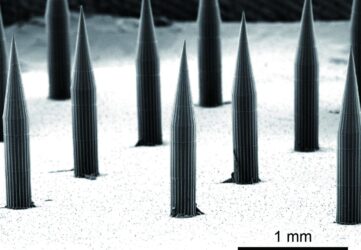
17 April 2020
Vaccines prevent disease and save lives; however, lack of standardised immunisation record keeping makes it challenging to track vaccine coverage across the world. McHugh et al. developed dissolvable microneedles that deliver patterns of near-infrared light-emitting microparticles to the skin. Particle patterns are invisible to the eye but can be imaged using modified smartphones. By codelivering a vaccine, the pattern of particles in the skin could serve as an on-person vaccination record. Patterns were detected 9 months after intradermal delivery of microparticles in rats, and codelivery of inactivated poliovirus led to protective antibody production. Discrete microneedle-delivered microparticle patterns in porcine and pigmented human skin were identifiable using semiautomated machine learning. These results demonstrate proof of concept for intradermal on-person vaccination record keeping.
Accurate medical recordkeeping is a major challenge in many low-resource settings where well-maintained centralised databases do not exist, contributing to 1.5 million vaccine-preventable deaths annually. Here, we present an approach to encode medical history on a patient using the spatial distribution of biocompatible, near-infrared quantum dots (NIR QDs) in the dermis. QDs are invisible to the naked eye yet detectable when exposed to NIR light. QDs with a copper indium selenide core and aluminum-doped zinc sulfide shell were tuned to emit in the NIR spectrum by controlling stoichiometry and shelling time. The formulation showing the greatest resistance to photobleaching after simulated sunlight exposure (5-year equivalence) through pigmented human skin was encapsulated in microparticles for use in vivo. In parallel, microneedle geometry was optimised in silico and validated ex vivo using porcine and synthetic human skin. QD-containing microparticles were then embedded in dissolvable microneedles and administered to rats with or without a vaccine. Longitudinal in vivo imaging using a smartphone adapted to detect NIR light demonstrated that microneedle-delivered QD patterns remained bright and could be accurately identified using a machine learning algorithm 9 months after application. In addition, codelivery with inactivated poliovirus vaccine produced neutralising antibody titers above the threshold considered protective. These findings suggest that intradermal QDs can be used to reliably encode information and can be delivered with a vaccine, which may be particularly valuable in the developing world and open up new avenues for decentralised data storage and biosensing.
Further Study
Evidence The COVID-19 Pandemic Is False
80% False Positives : SARS-CoV-2 Coronavirus Multiplex RT-QPCR Kit
Lockdown News